Agrisolar Ownership: A Guide for Farmers, Ranchers, Communities, and Landowners to Co-locate Agricultural Production and Solar Generation
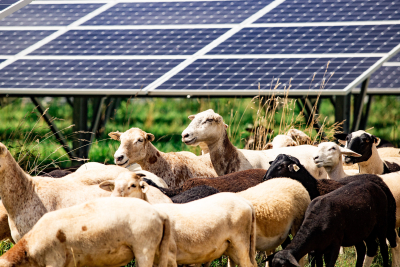
Photo: NCAT
By Carl Berntsen, NCAT Energy Engineer, with special acknowledgement of Chris Lent and Allen Puckett
May 2023
Abstract
This guide serves as an introduction to the solar industry, relative to agrisolar development in the United States, community programs, and solar ownership or lease opportunities for homes, farms, and ranches. It covers ownership options for small-scale, single-user solar installations, community solar installations that distribute power throughout a community, and utility-scale installations that sell power to the utility, as well as common utility-scale land-lease components for landowners looking to allow a developer to construct and operate a solar installation on a portion of their land. Finally, using nationwide average statistics on production and cost, the guide offers a financial snapshot of a utility-scale solar installation.
Contents
Introduction
Small-Scale Solar
Medium-Scale Solar
Utility-Scale Solar
Financial Snapshot of Large-Scale Solar Development
Conclusion
References
Introduction
This guide serves as an introduction to the solar industry, relative to agrisolar development in the United States, community programs, and solar ownership or lease opportunities for homes, farms, and ranches. The guide will touch on single-user systems in the 5kW – 50kW range, medium-scale solar projects in the 50kW and larger range, and utility-scale solar sites that are larger than 1MW. Utility and community solar power generation involves complex ownership structures where the solar site, solar power generating array, and power distribution network may be owned by different entities.
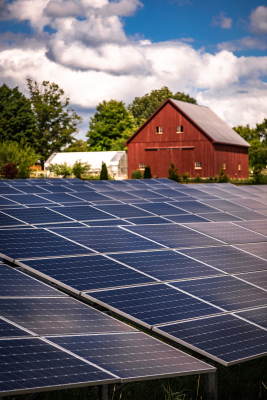
Photo: NCAT
From 2010 to 2020, the cost of utility-scale photovoltaic (PV) systems decreased by 82%, driven mainly by lower hardware costs, and PV module prices dropped 85% (Feldman, 2021). Solar power accounted for 0.1% of all power generated in the U.S. in 2010—increasing to nearly 5% in 2022—and for 50% of new electric capacity added to the grid (SEIA, 2022). Large- or utility-scale solar installations account for most of this increased solar generation capacity. The U.S. Department of Solar Energy Technologies Office (SETO) projects that solar capacity could account for more than 40% of all electricity generated by 2035 and could increase by seven times its current capacity by 2050 (SETO, 2021). Some of this capacity will come from solar installed on rooftops, capped landfills, parking lots, reclaimed mine lands, roadways, water bodies, agricultural lands, and in rural communities. The U.S. Department of Energy (DOE) estimates that 10 million acres of land nationwide will be required for solar by 2050 (SETO, 2021), 8 million of which will come from agricultural lands (Ardani et al., 2021). Large-scale solar systems are ideally suited for flat and sunny areas that are close to existing power infrastructure. These locations are also ideal for agricultural production. Improvements to energy generation and food production are not always viewed as complementary and many policies and development decisions around conservation practices, land and water allotments for agriculture, and permitting for large-scale renewable energy installations can prioritize either agriculture or solar but not both (Barron-Gafford et al., 2019). Agrisolar, also called agrivoltaics, is the co-location of agriculture and solar within the landscape. It includes solar co-located with crops, grazing, beekeeping, pollinator habitat, aquaculture, and farm or dairy processing. Certain states have provisions that allow for renewable energy siting when used in a complementary manner with agricultural production (Byrne, 2020). It is estimated that if agrisolar systems were used to meet all the United States’ current electricity demand, it could be accomplished using less than 1% of the country’s cropland (Adeh et al., 2019).
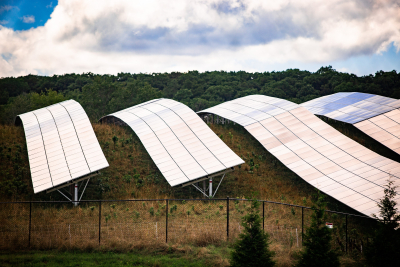
Photo: NCAT
Photovoltaic System Basics
Solar energy can be harnessed either by concentrated solar-thermal systems (CST), where sunlight is focused by mirrors to a collector where the heat is used directly or converted into electricity, or by PV systems that use sunlight to move electrons through semiconductors to produce an electric current. A PV system consists of panels or modules mounted on some sort of racking or structural system to form arrays. The modules produce direct current (DC) electricity that is inverted to alternating current (AC) by string inverters or micro inverters. The electricity produced is connected to a building’s power network “behind the meter” on the customer side of a utility meter, or to the grid to sell power. Installation locations of CST and PV systems depend on numerous variables, but one of most important is the size of the solar generating system. In the case of PV systems, arrays that produce on the order of 5 to 10 kilowatts (kW) of power can be located on rooftops of homes, but at the 1,000kW, or megawatt (MW), scale, entire acres of land will often contain ground-mounted solar arrays. Specifics such as sun “tracking” arrays, array spacing, ground unevenness, dual-use practices, and many others determine a solar system’s land requirements.
Typically Involved Parties
As system size increases, so does the complexity and the number of involved parties. In a typical small-scale solar system, the owner and solar contractor develop and construct the system. Community- and utility-scale systems typically involve a landowner, a solar developer who plans and owns the solar system, a solar contractor who installs the system, and an electric utility or cooperative that distributes the power. There does not need to be a combination of separate parties; any party can take on the tasks of another. For example, a landowner may choose to develop a solar site and retain ownership of the solar system, a solar developer may also purchase land to construct their own solar installation, or a utility may lease land from a landowner and develop a community-scale solar array. Large-scale system planning is more complex and includes community involvement, permitting, lawyers, financiers, insurers, land surveyors, civil engineers, and vegetation management specialists.
Small-Scale Solar
The median size of a residential solar array in 2018 was around 6kW DC. These systems are designed to generate power for onsite use and are commonly referred to as “behind the meter” installations, as the power generation and usage take place on the customer side of the utility power supply meter. The average installation cost per watt for a system this size was $2.71/W DC (Feldman, 2021). As systems get larger, the average cost per watt decreases, but these savings don’t start to really appear until 100kW DC, which is typically larger than a single user will need.
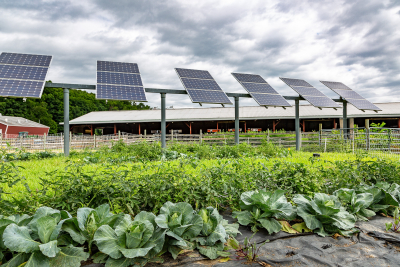
Photo: NCAT
In some states, it is possible for a customer to enter into a Power Purchase Agreement (PPA) with solar developer. The developer will install a solar system on a landowner’s property and sell the power to the landowner at a rate that is lower than the utility’s rate, thus saving the landowner money. The solar array will be owned, maintained, and eventually removed by the solar developer. The PPA rate will be high enough to eventually provide the developer with a return on investment (ROI) and generate a profit from the array. Otherwise, landowners can own their solar systems and have the array sized to offset all, or part of, their electricity usage. When an electric utility provides net metering, it will buy back any excess generated power, generally at the full retail rate, and credit a landowner for providing power for the grid. The savings provided by the solar installation will eventually pay for the up-front construction costs and provide an ROI. For instance, a 25kW system will have an upfront cost of $67,750 and yearly operations and maintenance costs of $725 (Feldman, 2021). At the national average electricity cost of $0.14/kWh, the energy produced each will offset $7,700 per year, providing an ROI in less than 10 years. This does not include federal investment tax credits. The U.S. Department of Agriculture offers the Rural Energy for America Program (REAP) Renewable Energy Systems & Energy Efficiency Improvement Guaranteed Loan & Grants. These loans and grants for agricultural producers and small businesses located in eligible rural areas can significantly reduce the ROI period (USDA, 2023). When an electric utility provides net billing, it will buy back excess generated power at a reduced rate. The rate varies by state and utility. Solar systems are then typically sized to offset baseline usage during peak consumption, thereby avoiding grid-storage as much as possible as the excess power is worth significantly less. In both metering instances, in the event of a grid power outage, a solar array is disconnected for safety reasons and will not generate power, and the home will experience a power outage. Some utilities don’t offer net metering or net billing, and all power generated must be used onsite and the excess generated power is lost. Adding a battery storage system to a solar system will allow for excess generated power to be stored and used later.
Medium-Scale Solar
Medium-scale solar systems include commercial and small community-scale systems in the 100kW to 1MW scale. Costs for ground-mounted systems decrease from $2.31/W DC for a 100kW system, $1.72/W DC for a 500kW system, to $1.59/W DC for a 1MW system. The cost per watt of the electrical balance of system, engineering-procurement-construction (EPC), and developer overhead decreases almost $0.43/W DC when comparing a 100kW system to a 2MW system (Feldman, 2021). While commercial systems are typically behind the meter and generate power for use onsite, community solar refers to systems that distribute power to a community of users. Community solar provides access to solar for individuals whose personal site lacks solar access due to shading, roof condition, roof orientation, or building ownership/rental status. For these reasons, community solar provides an opportunity for communities—especially low- and mid-income communities—to access solar technologies.
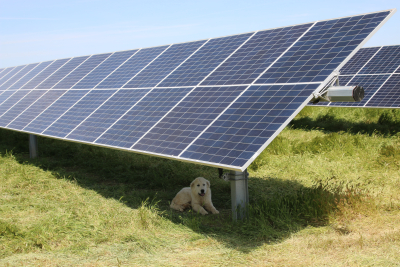
Photo: NCAT
As of December 2021, 39 states and Washington, D.C., had community solar projects installed. In these states, policies have been enacted to create a regulatory pathway for utilities and solar developers to develop community solar projects. As a result, it is possible for landowners to install a solar system on their property and sell the generated electricity to their local communities. The landowner owns the system, sells the electricity, and benefits from any other solar incentives that are in place. An alternative method is to pursue a solar developer that will lease the land from a landowner, and will build, own, and operate a community-scale solar system to distribute power to the community of users.
Subscription-Based Community Solar Programs
There are two models for community solar programs: ownership-based and subscription-based. An ownership-based model is where an individual buys individual solar panels or modules that are installed on a community solar array, and the power generated by those specific panels is credited to the owner’s electric bill. Subscription-based models are similar, but instead of buying panels up-front, the subscriber pays periodically to realize savings on their electric bill, which can vary from 5% to as much as 25% (EERE, no date). Programs like SunCommon or the Community Solar Subscription Tool were designed to create opportunities for low-income communities to participate in using solar energy. The Low-Income Home Energy Assistance Program (LIHEAP) helps low-income households pay their energy bills, and sometimes solar energy is an option if certain criteria are met—for example, that the benefit amount awarded to the household does not apply to things like installation fees, maintenance or equipment repair, inspections, or anything else typically related to using solar energy. Therefore, it could be possible for low-income households to use a LIHEAP benefit payment to participate in using solar energy. These programs allow a participant to rent solar panels from an already existing site that is managed and maintained by an entity other than the LIHEAP applicant. LIHEAP benefit amounts and state assistance programs vary from state to state, so what works in one state for low-income communities accessing solar energy may not be possible in another state. A state may require a start-up fee to participate in a subscription-based solar program, which would eliminate the possibility of a LIHEAP benefit payment being used for solar energy.
Utility-Scale Solar
Landowner Lease to a Solar Developer
Utility-scale solar sites are typically 2MW or greater and occupy 20-plus acres for 15 to 50 years. It is common for a solar developer to research locations and reach out to landowners to see if they would be interested in leasing land to install an array. Ideal locations for solar leases are within two miles of a power substation, are relatively flat, do not have much shading, and have good drainage for stormwater. There is a lot to consider with these leases due to the large land requirements and decades-long terms. All concerns and considerations must be addressed in the lease documents.
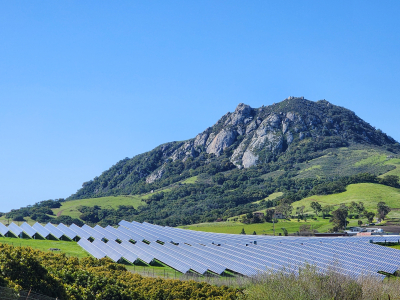
Photo: NCAT
Entering into such a long-term lease agreement should be approached with care (Hall et al., 2019). Solar leases take on many different forms. A developer may draft a Letter of Intent (LOI) to initiate the agreement, or approach with an option to lease agreement followed by a lease agreement, or a lease agreement with due diligence, construction, operations, and decommissioning phases. It is important for a landowner to know which terms of the document are negotiable and must be addressed for the benefit and protection of the landowner (Kiessling, 2022). The AgriSolar Clearinghouse strongly recommends landowners discuss this opportunity with an attorney, financial planner, accountant, and insurer who are familiar with solar leasing before entering into any agreement with a developer.
Options/Due Diligence Phase
The Options or Due Diligence Phase typically lasts one to three years. During this period, the developer demonstrates uninterrupted control of the site, which is often a requirement by utilities, obtains a PPA price from the utility, and applies for all the necessary permits. Depending on local rules, there may be a public review of the project where any interested party can make comments. Other existing agreements such as joint ownerships, existing mortgages, plans to leverage equity, farmland leases, hunting leases, mineral rights, and water rights must all be examined for potential conflicts. The local zoning rules may also inhibit solar development; however, it is common for a state to disallow a local authority from regulating a public utility, which may include utility-scale solar energy production. For these reasons, it is important for the landowner to enlist the help of an attorney familiar with solar lease agreements. During this phase, the landowner will be locked into negotiations, bound by confidentiality agreements to not discuss negotiations with others, and non-compete agreements to not work with other solar developers. There are limitations on what actions a landowner can take regarding their land. Often selling, leasing, or refinancing are limited or completely disallowed. The landowner will typically still have the same physical access to the land to continue routine operations and will be paid an amount by the developer to offset legal expenses (Kiessling, 2022). Another payment structure involves periodic payments of increasing value (Branan, 2022). This type of payment structure may prevent the options phase from proceeding long after a project has been abandoned and will lift the restrictions from the landowner.
Defining the Lease Land
It is common for a solar developer to only lease a portion of the landowner’s land. Initially, the developer may approach the owner to lease a large amount of acreage needed for the installatio, but then decide to lease a much smaller portion of land. It may be necessary to define a minimum acreage requirement, to ensure that, in the event a developer leases less land than originally proposed, the landowner is still compensated a worthwhile amount. There have been occurrences of solar developers proposing large land leases to gain access to beneficial easements and then not actually leasing any land at all but instead utilizing the easements for free.
Easements
Easements can be extremely valuable to developers looking to develop neighboring lands that need to access the grid through a landowner’s land. Therefore, easements should be defined in detail. Exclusivity rights, where the solar developer will have the only access, can result in common property used by the landowner becoming off limits. Certain easements should co-terminate with the lease agreement so that the easements cease to exist once the array is decommissioned. Compensation for easements should also be discussed. Rates for easements can vary widely, depending on the developer’s need.
Non-Interference Clauses
The solar developer will also have non-interference provisions in place to limit development outside of the leased area to protect the solar array from permanent sources of shade, such as buildings. Clearly defining this provision is necessary so that it cannot be used to limit development on the landowners’ land that would not have any impact on the performance of the solar arrays. Additionally, land that becomes landlocked by leased land and inaccessible to the landowner should also be compensated for. Any land unaffected by the lease should be noted as excluded land and thereby unaffected by lease.
Vegetation Management Plan and Prescribed Grazing Plan
A Vegetation Management Plan (VMP), also referred to as an Integrated Vegetation Management (IVM) program, becomes of key importance for operations and maintenance of community- and utility-scale solar sites. Some states have made VMP a requirement during the permitting phase of a utility-scale solar development (Benage et al., 2021). An effective VMP prevents vegetation from negatively impacting the technical performance of solar assets, operational safety, and regulatory compliance. Making informed decisions on vegetation management practices can help avoid costly maintenance expenses, such as stormwater erosion repair, throughout a solar project’s lifetime. A VMP that includes pollinator habitat will provide ecosystem services to the surrounding community (EPRI, 2020).
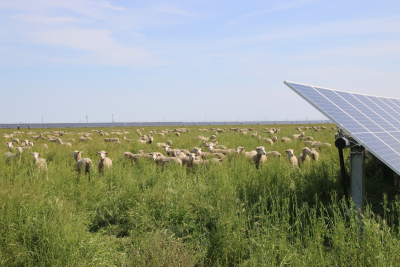
Photo: NCAT
Gravel or planting turf grass are conventional ground-cover treatments beneath an array. However, VMPs that utilize sheep grazing and/or planting native vegetation have comparable yearly costs to gravel and turf grass (McCall et al., 2023). If the site is to be grazed, a Prescribed Grazing Plan (PGP) should be developed in the planning phase to include stock rates, time of grazing, class of animals, and vegetation standards. This will allow for planning and feedback that will result in healthier soils and plant communities and reduce erosion and overgrazing (Macknick et al., 2022). Agrisolar practices utilized in a system’s VMP for a community- or utility-scale solar power-generation site will keep land in agricultural production while also generating electricity and providing an alternative revenue opportunity for landowners.
Construction
The duration of the construction phase often depends on the size of the installation and site specifics, such as soil type and terrain. It is in the developer’s best interest to complete this phase as quickly as possible and they often will do so in less than one year. The large equipment used at these sites can compact soils and alter water drainage causing increased runoff and erosion. Soil compaction negatively impacts plant growth that is detailed in the array’s vegetation management plan, and when returning the land back to agricultural purposes after decommissioning. If construction affects large areas of land, vegetation and wildlife may also be negatively impacted. By utilizing low-impact construction techniques and de-compacting soils after construction, the negative impacts of construction can be greatly reduced (Macknick et al., 2022).
Operations and Maintenance
The lease enters the operation phase once arrays are fully constructed, and the developer begins selling energy to the grid. This phase lasts as long as the panels are generating an acceptable amount of energy for the developer, typically around 25 years. During the operations phase, very few personnel are onsite at any given time. The developer will remotely monitor the performance of the power plant. There will be routine groundskeeping, equipment cleaning and maintenance, troubleshooting, and repair/replacement of malfunctioning components. Vegetation management is a crucial maintenance process to prevent shading of the panels, and a detailed vegetation management and/or prescribed grazing plan is required to be in place during the permitting phase (McCall et al., 2023).
Taxes: Incentive or Penalty
Taxes vary widely according to regional and state rules. Most states have some form of agricultural use reduced tax rates that do not allow for any form of development. In the event of development, even on a portion of land, a penalty tax can be assessed against the entire property. This can take the form of repayment of taxes for previous years. It can be negotiated for a solar developer to take on these penalties and increased property taxes. Conversely, some states will waive property taxes on solar development as an incentive. Knowing if a landowner’s property will be penalized or rewarded before the construction phase is very important for planning and determining fiscal responsibility. The AgriSolar Clearinghouse has a funding map that contains information on federal and state financial incentives.
Clean Energy Demonstration Program on Current Former Mine Land
If the landowner’s property is a current or former mine land, landfill, contaminated land, or degraded land, there are government programs to aid in solar development. DOE’s Clean Energy Demonstration Program on Current and Former Mine Land program (CEML) supports development of clean energy projects on current and former mine lands. The goal is to find replicable solutions to key issues involved in clean energy on current and former mine lands. To support this, DOE has created a funding opportunity announcement for this program here.
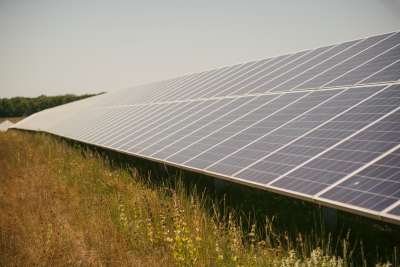
Photo: NCAT
Similarly, the U.S. Environmental Protection Agency’s (EPA) RE-Powering America’s Land initiative encourages renewable energy development on former landfills, contaminated lands, degraded lands, and mines (EPA, 2012). RE-Powering America’s Land fact sheet summarizes the benefits to solar development on contaminated lands, such as lower land costs, access to existing road and electricity transmission infrastructure, streamlined permitting and zoning, and extra federal and potential state tax incentives. Linking the priorities of environmental remediation and open-space preservation with power generation turns blighted properties into community assets.
Repowering or Decommissioning
The planned lifespan of a solar array is typically 25 to 30 years. At the end of the lifespan, the solar panels’ production has degraded to the point where either they must be repowered, or the site must be decommissioned. A repowering event is when the developer will replace malfunctioning equipment with new panels and repair or refurbish any equipment that is no longer working optimally. This is a very attractive option as the permits and lease agreements can be easily extended, land improvements and existing infrastructure can be reused, and the existing racking systems often has enough life left for another 25 to 30 years, depending on materials and maintenance. Often, repowering arrays will also increase the generation capacity of the installation because the newer technology is more productive. The operation lease rate can be renegotiated due to the increased solar income. For the facility to be fully decommissioned, the land must be returned to its original state. Reclamation bonds or escrow accounts are financial accounts that are fulfilled by the developer to ensure final decommissioning. The solar developer will often request to fulfill these financial burdens after multiple years of production due to the large initial capital expenditures.
PV Recycling or Disposal
Solar recycling technology is not widely available because 75% solar panels in use today have two decades of expected life left (Huang, 2022). Solar panels are made of glass, aluminum, copper, silver, and semiconductor materials. About 80% of a solar panel is comprised of commonly recycled materials. However, due to the 25+ year lifespan of solar panels and the recent boom in solar installation, most of the solar panels in the U.S. are still in operation. As a result, solar recycling technology is in its infancy. It is estimated that 78% of solar array materials can be recycled, but this value will likely increase in the future as more solar cites are being repowered or decommissioned (EERE, 2022). In the event of disposal at a landfill, much of the PV panel is not considered hazardous waste. Some of the semiconductor material and solder can contain lead and cadmium, which are considered hazardous in high enough quantities. The Resource Conservation and Recovery Act of 1976 (RCRA) contains exclusions for some solar panels. While some solar panels are considered hazardous waste, some are not, even within the same model number and manufacturer, so it is important to understand these exclusions before disposing of solar panels (EPA, 2022). Additionally, some states have enacted specific policies on the disposal of solar panels.
Financial Snapshot of Large-Scale Solar Development
The initial capital expenditures in developing a utility-scale solar site at the 100MW DC scale have dropped to $0.94/W DC for fixed-tilt systems and $1.01/W DC for single-axis tracking systems. The yearly cost decreases are linked to largely to higher-efficiency modules, which results in less panels per watt of production, less structural racking system requirements, and less labor and overhead, and land acquisition moving from a large upfront cost to an operations and maintenance yearly lease cost. While single-axis trackers are more expensive up front, by following the sun through the sky, they produce more power each year. A portion of these costs are set profits by the developer that are between 8% for a system on the 1MW, or more, scale to 5% on the 100MW scale. To determine the yearly income of a utility-scale solar installation use, the following formula:
Yearly Income = Size of array in DC x AC Capacity Factor x PPA x 8,760 (hours/year)
The PPA is the Power Purchase Agreement price that is negotiated with the utility. In 2021, the average value in the southwestern states was $20/MWh, and $30-$40/MWh in the rest of the continental U.S., with Hawaii being higher. The AC Capacity Factor is a number that represents a site’s percentage of time that the array produces nameplate power. This value considers the region’s weather and solar resource value. The national average of capacity factors for newly installed solar sites in 2021 was 25% (Bollinger, 2022). For a developer, a 2MW solar farm will cost around $2.68 million to install on 10 to 20 acres of land. Almost $880,000 of this upfront cost is EPC/developer profit, cost, and land acquisition. With a PPA of $35/MWh, the site will generate around $153,000. Average operations and maintenance cost for a solar farm this size is $17.47/kW DC/yr (Wiser et al. 2020). This equates to about $35,000/yr, resulting in a net income of $118,000/yr. This results in a simple ROI period of 22 years and, during its 25-year life, the array will generate $2.96 million. Additionally, systems that are placed in service in 2022 or later and that begin construction before 2033 are eligible for a 30% Investment Tax Credit, or a 2.75 cents/kWh production tax credit, if they meet labor requirements or are under 1MW in size (EERE, 2023).
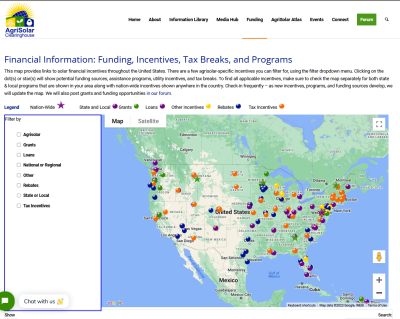
Photo: NCAT
The National Renewable Energy Laboratory (NREL) produced the System Advisor Model (SAM) to use local capacity factors, industrial power prices, and PPA prices to obtain regionally informed estimates of solar production income. Additionally, there are national and statewide incentives, programs, and tax breaks for solar generation facilities. Information about these programs can be found on the AgriSolar Clearinghouse’s Funding Map. From the perspective of the solar site, utilizing agrisolar practices in the VMP is considered an operations and maintenance cost; however, for a landowner, it is an opportunity to maintain agricultural production from the solar array site. For a landowner to develop a utility-scale solar array without a solar developer, they would need to work with a solar contractor on the design and construction of the solar system and negotiate a PPA price with a utility. The following case study highlights a landowner-operated, community solar development in Mason, Massachusetts.
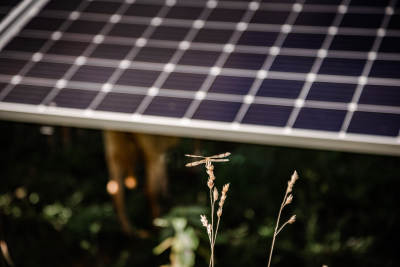
Photo: NCAT
Case Study: Million Little Sunbeams
Nate Tassinari purchased what remained of his family’s farm, 160 acres of land, from his grandmother to keep the land in the family. He needed to find a way to make the acquisition work financially. He investigated timbering and development, both of which could have helped pay for the land, but Nate and his family did not want to see the land stripped of trees and lined with houses and other buildings. His hope was to see the land continue to be farmed by his relatives that still lived near the property.
In 2020, Nate worked with Sun Bug Solar to design and install a 250kW solar array on his property. They designed a system that would meet the SMART program requirement of being able to farm under the panels. This required elevating the panels and spacing the support structure so haying and other farm equipment could operate. They added two other features to improve the efficiency of the system. The panels were installed on a single-axis tracking system that allows the panels to follow the sun from east to west across the sky each day. This allows the sun to hit the panels at an optimal angle at all times, producing more electricity compared to a stationary or fixed array. They also installed power optimizers under each solar panel, which increase the output of each panel and prevent problems with one panel from affecting the performance of the rest of the panels in the system. Though these features added to the upfront costs, they increased electricity production by an estimated 20 to 30% over the life of the system.
Nate set up a separate business as the legal entity that owns and manages the system. He named it Million Little Sunbeams after a book by a favorite child author of his. Through this business, Nate can sell the electricity produced to homes in the area, mostly neighbors, who then send payment to Million Little Sunbeams. Because the system meets criteria of the SMART incentive program, Million Little Sunbeams receives a premium rate for the electricity generated. The SMART program offers solar owners a fixed-rate tariff, meaning if you produce the electricity, the utility must pay you a set amount for a predetermined number of years. Credits are produced based on the electric generation of the system and are sold to subscribers. Million Little Sunbeams bills the subscribers directly and offers them a discount on the credits.
With this structure, Nate has found a viable option to hold onto the land that had been in his family for generations. He is also able to benefit from all the solar incentives like depreciation on the system, tax credits, and the premium rates, which would not be the case if he leased his land to a solar developer or a utility. With the incentives, Nate estimates a five-year payback on the project. This model could be a viable alternative to leasing in areas with higher electricity costs and a dense population that still maintains a mix of urban and rural landscapes. It could work economically for farms that want to offset a high energy load for the farm.
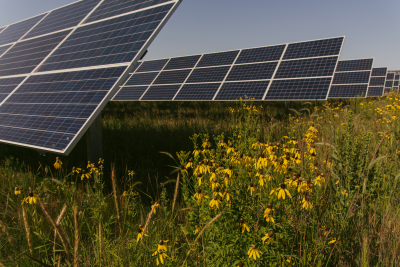
Photo: NCAT
Conclusion
There are many ownership options for small-scale, single-user solar installations, community solar installations that distribute power throughout a community, and utility-scale installations that sell power to the utility to distribute to customers. When working with a solar developer to lease land for a utility-scale installation, there are important lease topics that a landowner must consider when allowing a developer to construct, own, and operate a solar installation on a portion of their land. While this guide used nationwide average statistics on production and cost to give a financial snapshot for landowners interested in constructing, owning, and operating a utility-scale solar installation, landowners should always consider local costs for their project.
References
Adeh, E.H., S.P. Good, M. Calaf, and C.W. Higgins 2019. Solar PV Power Potential is Greatest Over Cropland. Scientific Reports 9, 11442(2019).
AgriSolar Clearinghouse. 2023. Financial Information: Funding, Incentives, Tax Breaks, and Programs.
Ardani, K. et al. 2021. Solar Futures Study. September. Barron-Gafford, G.A., M.A. Pavao-Zuckerman, et al. 2019. Agrivoltaics provide mutual benefits across the food-energy-water nexus in drylands.
Benage, M., J. MacAlister, S. Roos, D. Shaw, and C. Warzecha. 2021. Guidance for Developing a Vegetation Establishment and Management Plan for Solar Facilities. Minnesota Department of Commerce.
Bolinger, M. and G. Bolinger. 2013. Land-Use Requirements for Solar Power Plants in the United States. National Renewable Energy Laboratory, Golden, CO.
Branan, R.A. 2022. Legal Issues Surrounding Due Diligence for Solar Development. NC State Extension. February 15.
Byrne, G. 2020. Farmland Solar Policy Design Toolkit. The Farm and Energy Initiative. U.S. DOE Office of Energy Efficiency & Renewable Energy (EERE). 2021. Solar Futures Study. September.
EERE. 2022. Solar Energy Technologies Office Photovoltaics End-of-Life Action Plan. March.
EERE. 2023. Federal Solar Tax Credits for Businesses. Office of Energy Efficiency and Renewable Energy. April.
EERE. No date. Connect the Dots on Community Solar. Office of Energy Efficiency and Renewable Energy.
Electric Power Research Institute (EPRI). 2020. Land Use Considerations for Large-Scale Solar. Palo Alto, CA.
Feldman, D. 2021. U.S. Solar Photovoltaic System and Energy Storage Cost Benchmark: Q1 2020. Golden, CO: National Renewable Energy Laboratory.
Hall, Bachelor and Eric Romich. 2019. Farmland Owner’s Guide to Solar Leasing. The National Agricultural Law Center.
Huang, S.E. 2022. Solar Energy Technologies Office Photovoltaics End-of-Life Action Plan. U.S. Department of Energy, Office of Energy Efficiency & Renewable Energy.
Kiessling, J.H. 2022. Leasing your Land for Solar Energy Development. March 16.
Macknick, J., H. Hartmann, and G. Barron-Gafford. 2022. The 5 Cs of Agrivoltaic Success Factors in the United States: Lessons From the InSPIRE Research Study. National Renewable Energy Laboratory, Golden, CO.
McCall, J., J. Macdonald, R. Burton, and J. Macknick. 2023. Vegetation Management Cost and Maintenance Implications of Different Ground Covers at Utility-Scale Solar Sites. Sustainability. February 15.
Solar Energy Industries Association (SEIA). 2022. Solar Industry Research Data.
U.S. Department Agriculture (USDA). 2023. Rural Energy for America Program Renewable Energy Systems & Energy Efficiency Improvement Guaranteed Loans & Grants.
U.S. Environmental Protection Agency (EPA). 2012. RE-Powering America’s Land. July 17.
U.S. EPA. 2022. End-of-Life Solar Panels: Regulations and Management. August 28.
Wiser, R.H., M. Bolinger, and A.J. Seel. 2020. Benchmarking Utility-Scale PV Operational Expenses and Project Lifetimes: Results from a Survey of U.S. Solar Industry Professionals. Lawrence Berkeley National Laboratory, Berkeley, CA
AgriSolar Ownership: A Guide for Farmers, Ranchers, Communities, and Landowners to Co-locate Agricultural Production and Solar Generation By Carl Berntsen
NCAT Energy Engineer
Published May 2023


